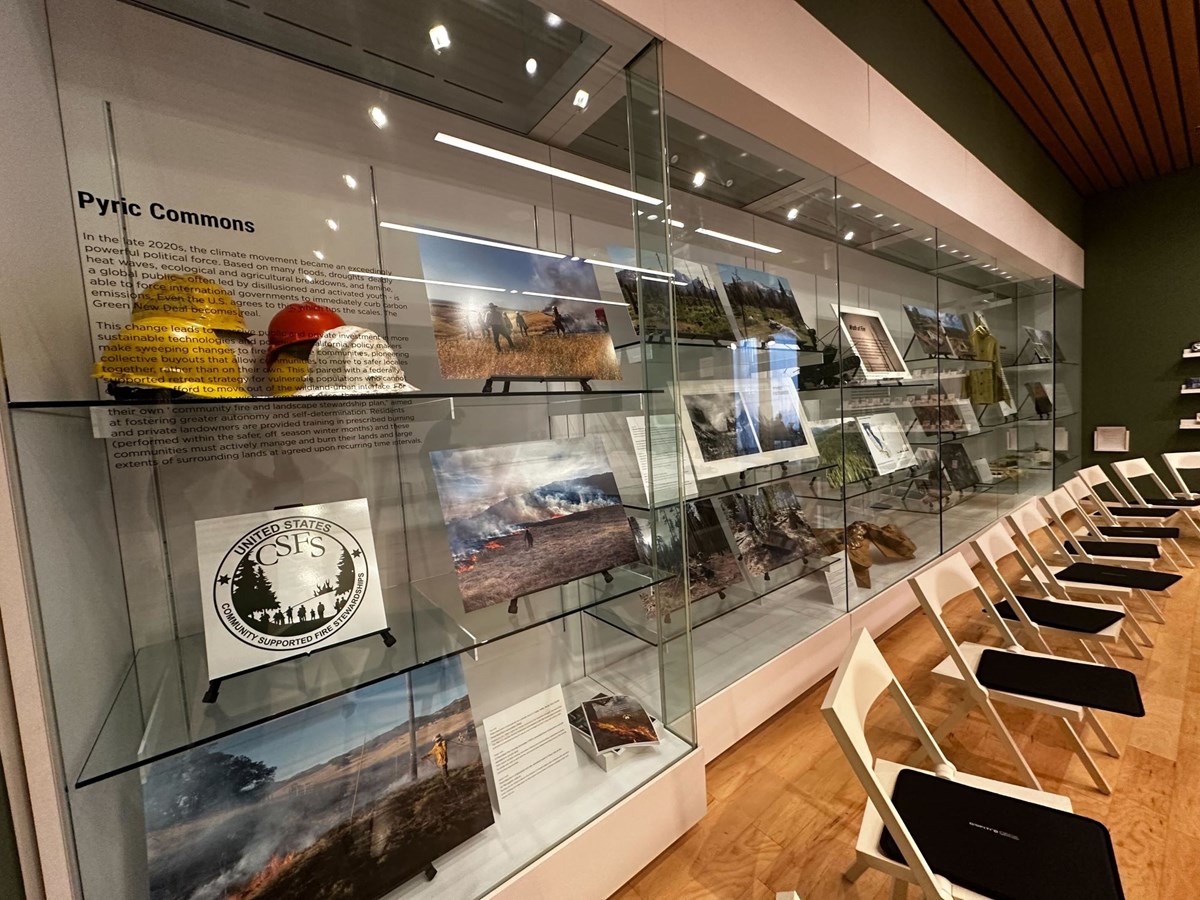If you’re driving on Interstate 80 between Sacramento and Davis, you might spot a billboard displaying an animal wildfire mascot. But it isn’t Smokey Bear.
It’s Burnie the Bobcat, with a new slogan: Only you can decide our fiery future.
“We thought, what if Smokey Bear could use a friend?” said Emily Schlickman, an assistant professor of landscape architecture and environmental design at UC Davis. “But a friend that would light fires instead of fighting them.”
The billboard is an advertisement for the new “Pyro Futures” exhibition, which opened at the start of January at the university’s Manetti Shrem Museum. Schlickman, alongside UC Davis professor of landscape architecture Brett Milligan, built the exhibition off a chapter of the book they co-authored called “Design By Fire.”
In the exhibition, the two explore how wildfire management decisions could shape the country’s future. Milligan said different items on display — including firefighting helmets and burnt items — are meant to trigger the imagination of the viewer so they can more viscerally understand what these futures might look like.
“They vary quite a bit from being optimistic and hopeful to a more disastrous scenario if we continue to not do proactive action around fires,” Milligan said.
 In the exhibition, different items on display — like firefighter helmets and burnt items — help visitors explore how wildfire management decisions could shape the country’s future.Manola Secaira/CapRadio
In the exhibition, different items on display — like firefighter helmets and burnt items — help visitors explore how wildfire management decisions could shape the country’s future.Manola Secaira/CapRadio
The futures presented in the exhibition include positive visions, like one where California promotes Indigenous land stewardship and allows tribes to reassert their rights to cultural burning. That in turn could impact the U.S. Forest Service as a whole, and transform it into a radically different institution.
But in a different scenario, one where nothing is done to curb emissions and megafires continue to spread, the exhibition suggests a future where climate conditions worsen exponentially. In this part of the exhibit, the curators showcase examples of what forest trees look like in areas where fire has been frequently suppressed.
“Much of what we're talking about here are things that are already in play,” Milligan said.
From Smokey to Burnie
One part of the exhibition suggests wildfire mascots that could help evolve public understanding of California’s relationship with fire. Burnie the Bobcat is one of them. Schlickman said the species is helpful in showcasing the benefits intentional fire can bring to a landscape.
“They often live in these pyrophytic [fire-adapted] shrub lands, so they need these low-intensity fires to clear out these shrub lands,” she said. “Post-fire, bobcats benefit from prey that occupy this kind of rejuvenated landscape, so they inherently benefit right from these fires.”
Milligan said this more playful part of the exhibition is another way to explore the personal relationships people have with fire. With Smokey, a bear often represented in recent years as stern and muscular, he sees a history where the relationship people have had with fire is one based on domination and suppression of it in its entirety.
(Left) A billboard on Interstate 80 between Sacramento and Davis displays Smokey Bear. (Right) The same billboard later shows Burnie the Bobcat from the Pyro Futures exhibition.Courtesy Emily Schlickman
“You can see across time [all] the different ways he's presented, but the message has been pretty much the same throughout with some modifications,” he said. “I think it's a really interesting question of if Smokey's message will change or become more nuanced over time.”
The exhibition includes journals with writing prompts, inviting visitors to share their own visions for California’s future with fire, as well as other ideas for animal mascots. Many of these prompts can be answered online via the exhibition’s website as well.
“I think if we're going to change how we go about fire, that's going to have to be predominantly a cultural change,” Milligan said. “Our scenarios are just three guesses and they're just meant to be a tool to think about it. But what do other people think the future holds?”
Schlickman said the I-80 billboard had displayed a Smokey Bear advertisement right before Bernie the Bobcat took over. It’s a funny coincidence she and Milligan couldn’t have planned, but in some ways, she said it adds to their message.
“There’s still a place for him, and his message,” she said. “But that’s why we think there could be an additional mascot that could be added to the mix.”
Both curators will be at the museum to host an opening event for the exhibition on Jan. 28 from 3 to 5:30 p.m. The exhibition will remain at the museum until June 16. The curators are hoping to host in-person events in the museum related to the exhibition’s focus in coming months.
CapRadio provides a trusted source of news because of you. As a nonprofit organization, donations from people like you sustain the journalism that allows us to discover stories that are important to our audience. If you believe in what we do and support our mission, please donate today.
Donate Today